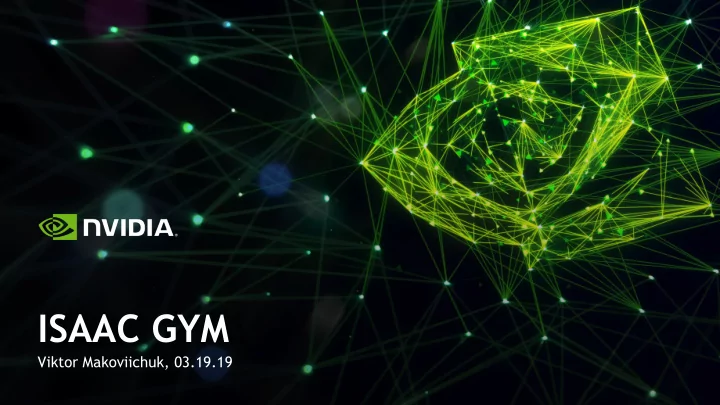

ISAAC GYM Viktor Makoviichuk, 03.19.19
SIMULATION IN ROBOTICS • Limited access to hardware • Well-controlled experiments • Good progress recently in Sim2Real Dexterous Manipulation Grasping in Clutter Quadruped Locomotion Mahler and Goldberg, 2017 Jemin et al, 2019 OpenAI, 2018 UC Berkeley ETH 2
MOTIVATION Reinforcement Learning OpenAI Five AlphaZero OpenAI, 2018 Deepmind, 2018 3
APPLICATIONS Reinforcement Learning Locomotion/Animation Liang, Makoviychuk, Handa et al, 2018 NVIDIA 4
APPLICATIONS Robotics Sim2Real Robotics Chebotar , Handa, Makoviychuk, et al, 2018 NVIDIA 5
ISAAC GYM Platform for high-performace AI Learning Experiments 6
ISAAC GYM Key Goals Simple to get started Procedural API for scene and model definition Performance (from Python) and scalability Fast, high-fidelity physics/multi-physics Fast, high-quality image generation Visualization and camera sensors, fast multi-camera rendering Decoupling of graphics/physics Learning algorithm/framework agnostic 7
ISAAC GYM Key Features Multiple physics backends Multiple rendering backends Support for multiple robot definition formats Many environments simulated in parallel Scalable: Many simple/single-agent environments Complex/multi-agent environments 8
ISAAC GYM PhysX FleX Gym Physics Importers MJCF C++ Application Gym API Gym Framework URDF Asset (.so/.dll) Python OpenSim RL Module Isaac Gym Other Gym Bindings Gym Graphics Other Simple RTX 9
PHYSICS PhysX New 4.x version for robotics, reinforcement learning and engineering applications Maximal coordinate representation and articulations Performance and scalability From small training environments to large city-scale worlds CPU and GPU simulation 10
PHYSICS PhysX 11
PHYSICS FleX Research features backends • • Only GPU simulation New Newton solver • • Multi-physics 12
PHYSICS FleX • Multi-physics Rigid and FEM soft bodies • Cloth, ropes • • Liquids • Two-way coupling and force propagation between different phases 13
PHYSICS FleX 14
PHYSICS FleX 15
RENDERING Multiple Rendering Backends Vulkan-based Raster • • Fast raster graphics Simple materials and lights • RTX-based Ray-Tracing • • High-fidelity hardware-accelerated ray tracing Support for MDL/complex materials • Area lights, ambient occlusion, reflections, refraction • 16
RENDERING Camera Sensors Camera sensors • Free control • • Fixed Attach to bodies • Render to image buffers • • Input to visual learning algorithms Output • High Performance – thousands of images per second • 17
USING ISAAC GYM Use native C++ API or python bindings • • Scalable execution: Single laptop/desktop • • Cluster • Remote viewer to visualize results of training on server/cluster Includes example environments / experiments • 18
USING ISAAC GYM from isaacgym import gymapi # initialize gym gym = gymapi. acquire_gym () # create a viewer (optional) viewer = gym. create_viewer (None, 1920, 1080); # load asset robot_asset = gym. load_asset ("../assets", “ franka.urdf") # create a simulation sim = gym. create_sim () # get default sim params params = gymapi.SimParams() gym. get_sim_params (sim, params) # set custom sim params params.gravity = gymapi.Vec3(0.0, -9.8, 0.0) params.solver_type = 5 params.num_outer_iterations = 4 params.num_inner_iterations = 10 params.relaxation = 0.75 params.warm_start = 0.5 gym. set_sim_params (sim, params) 19
USING ISAAC GYM # specify number of envs in the simulation # - multiple envs can be stepped in parallel num_envs = 1024 # specify environment spacing and bounds spacing = 2.0 lower = gymapi.Vec3(-spacing, 0.0, -spacing) upper = gymapi.Vec3(spacing, spacing, spacing) # initialize an array of environments using a procedural API # - easy to randomize properties for i in range(num_envs): # create env env = gym. create_env (sim, lower, upper) # add actor pose = gymapi.Transform(gymapi.Vec3(0.0, 2.0, 0.0), gymapi.Quat(-0.707107, 0.0, 0.0, 0.707107)) gym. create_actor (env, robot_asset , pose, “ franka") # set some simulation parameters dt = 1.0 / 60.0 num_substeps = 2 20
USING ISAAC GYM # main loop while not gym. query_viewer_has_closed (viewer): for i in range(num_envs): torque = 20.0 # get some useful handles (this can be done before the main loop) env = gym. get_env (sim, i) joint3_handle = gym. get_joint_handle (env, “ franka ", “panda_joint3") # apply efforts to individual joints gym. apply_joint_effort (env, “panda_joint3 , torque) # step the simulation gym. simulate (sim, dt, num_substeps) gym. fetch_results (sim, True) # update the viewer gym. step_graphics (sim) gym. draw_viewer (viewer, sim, True) # Wait for dt to elapse in real time. # This synchronizes the physics simulation with the rendering rate. gym. sync_frame_time (sim) 21
EXAMPLES Locomotion 22
EXAMPLES Locomotion 23
EXAMPLES Locomotion 24
EXAMPLES Robotics Trained using RL in • Isaac Gym RTX renderer, • raytraced reflections and refractions 25
WHAT’S NEXT? Further performance optimization: • • GPU observations and control No-copy communication of camera image to learning framework • • More training environments and examples: robotics, locomotion, multi-agent • Physics: Support of deformable objects – soft bodies, cloth, etc • • Soft actuators • Early access soon (Contact if interested!) General release in 2019 • 26
Thank You! vmakoviychuk@nvidia.com
Recommend
More recommend